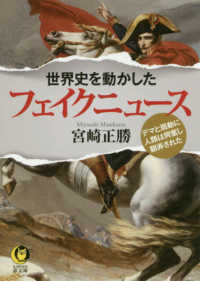Full Description
In this text Jardine, Clifford, and Friesen set forth their concept of curriculum as abundance and illustrate its pedagogical applications through specific examples of classroom practices, the work of specific children, and specific dilemmas, images, and curricular practices that arise in concrete classroom events. The detailed classroom examples and careful philosophical explorations illustrate the difference it makes in educational theory and classroom practice to think of the curriculum topics entrusted to teachers and students in schools as abundant.
The central idea is that viewing what is available to teachers and students in classrooms as abundant, rather than scarce, makes available the unseen histories, language, images, and ideas in everyday classroom life-makes it possible to break open the flat, literal "ordinariness" of classroom events, makes their complex and contested meanings visible, understandable, and pedagogically useful. Understanding the disciplines entrusted to schools (such as mathematics, writing, reading) as living inheritances, not as inert, finished, static, manipulable objects, means that the work of the classroom requires getting in on the real, living conversations that constitute these disciplines as they actually function in the classroom. This view of curriculum as abundance has a profound effect on classroom practice.
Curriculum in Abundance addresses curriculum and teaching topics such as mathematics, science, environmental education, social studies, language arts, and the arts curriculum; issues that arise from inviting student-teachers and practicing teachers into the idea of curriculum of abundance; the issue of information and communications technologies in the classroom; and the philosophical underpinnings of constructivism and the dilemmas it poses to thinking about curriculum in abundance. All of the chapters provide images of how to conduct interpretive research in the classroom.
This critically important text for undergraduate and master's-level courses on curriculum methods, curriculum theory, teacher research, and philosophy of education speaks eloquently to students, teachers, teacher educators, and researchers across the field of education.
Contents
Contents: Foreword. Preface. Introduction. S. Friesen, P. Clifford, D.W. Jardine, Preamble One: From Scarcity to Impoverishment. Chapter One: Ahn Linh's Shapes. D.W. Jardine, Preamble Two:Signs of Abundance. Chapter Two: Eight Pedagogical Preambles on Dolly the Sheep. D.W. Jardine, Preamble Three:On Play and Abundance. Chapter Three: "Let Eric's Age Be "X'": A Brief Mathematical Phenomenology. D.W. Jardine, Preamble Four:Do They or Don't They?. Chapter Four: Welcoming the Old Man Home: Meditations on Jean Piaget, Interpretation, and the "Nostalgia for the 'Original'". D.W. Jardine, S. Friesen, P. Clifford, Preamble Five:On Ontology and Epistemology. Chapter Five: "Behind Each Jewel Are Three Thousand Sweating Horses": Meditations on the Ontology of Mathematics and Mathematics Education. D.W. Jardine, Preamble Six: Getting Over the Great Humiliation. Chapter Six: Abundance and the Limits of Teacher Knowledge. D.W. Jardine, J.C. Field, Preamble Seven:Monsters in Abundance (With Brent Novodvorski). Chapter Seven: "Disproportion, Monstrousness, and Mystery": Ecological and Ethical Reflections on the Initiation of Student Teachers Into the Community of Education. D.W. Jardine, Preamble Eight:"Catch Only What You've Thrown Yourself...". Chapter Eight: Cutting Nature's Leading Strings: A Cautionary Tale About Constructivism. B. Johnson, L. Fawcett, D.W. Jardine, Preamble Nine: Stepping Away From the Marriage of Knowledge and Production. Chapter Nine: Further Thoughts on "Cutting Nature's Leading Strings": A Conversation. D.W. Jardine, Preamble Ten: "Within Each Dust Mote...". Chapter Ten: "The Fecundity of the Individual Case": Considerations of the Pedagogic Heart of Interpretive Work. D.W. Jardine, Preamble Eleven: "Given Abundance...". Chapter Eleven: On the Integrity of Things: Reflections on the "Integrated Curriculum." D.W. Jardine, Preamble Twelve: Settling and Unsettling. Chapter Twelve: "Under the Tough Old Stars": Meditations on Pedagogical Hyperactivity and the Mood of Environmental Education. D.W. Jardine, Preamble Thirteen:Kai Enthautha Einai Theous. Chapter Thirteen: On the Ecologies of Mathematical Language and the Rhythms of the Earth. D.W. Jardine, S. Friesen, P. Clifford, Preamble Fourteen: Abundant Webs. Chapter Fourteen: "If You Want To": Inquiry and the Arrival of New Information and Communications Technologies Into the World of the Classroom. D.W. Jardine, J. Batycky, Preamble Fifteen:The Abundance of the Future. Chapter Fifteen: Filling This Empty Chair: On Genius and Repose. D.W. Jardine, Preamble Sixteen: Covering the Curriculum. Chapter Sixteen: The Individual Student. D.W. Jardine, T. Graham, A. LaGrange, H. Kisling-Saunders, Preamble Seventeen:The Face of "The Real World". Chapter Seventeen: Staying Within the Lines: Re-Imagining What Is "Elementary" in the Art of Schooling. D.W. Jardine, T. Graham, S. Friesen, P. Clifford, Preamble Eighteen: Murmuring Over Texts. Chapter Eighteen: In His Own Hand: Interpretation and the Effacing of the Scribe. D.W. Jardine, Preamble Nineteen:On Emptiness and Abundance. Chapter Nineteen: Unable to Return to the Gods That Made Them.








